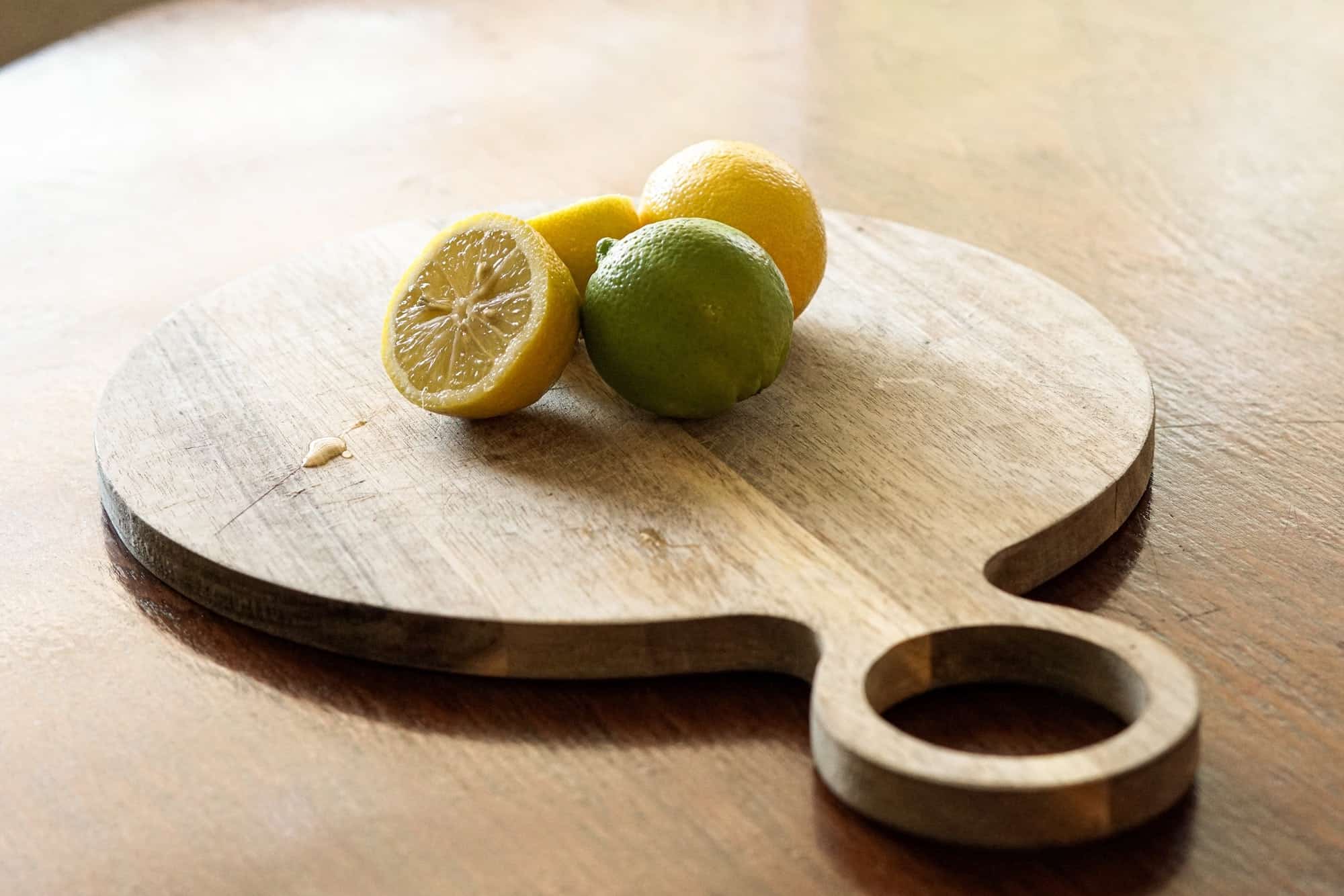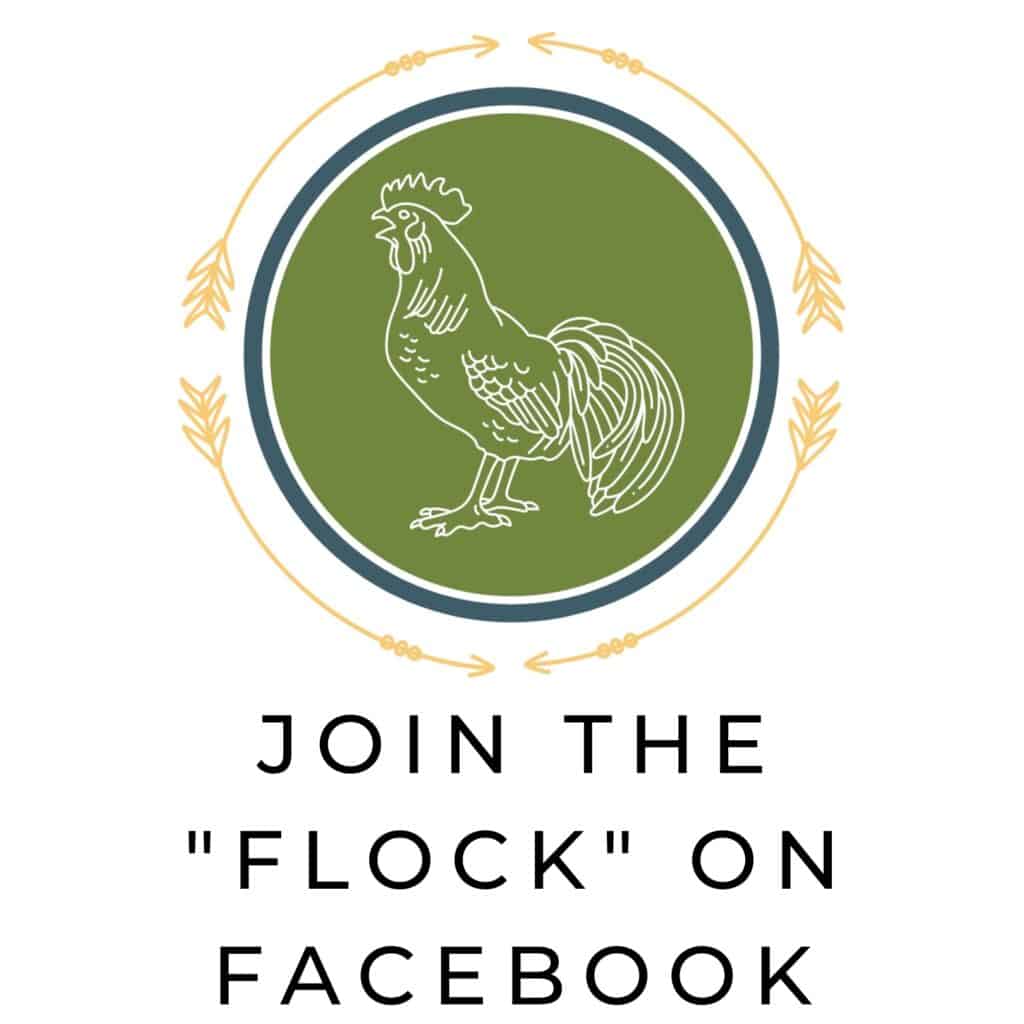This post may contain affiliate links. Please read our disclosures for more information.

Cutting boards are perhaps one of the last things you’d think of as a farm-made product, yet are perhaps one of the single most commonly used items on any farm!
Beth and Kevin, at Home To Roost Co, are changing that opinion, one kitchen at a time. The best part of their business? Sustainability is the key.
They’ve built an incredible Etsy business (visit HomeToRoostCo on Etsy to shop their products) making not just handmade, homemade cutting boards, but also wood farmhouse-style signs and decor. They’re also making a point of making it a meaningful business too. Every cutting board (and wood sign) they make is actually made from timber harvested from right on their own farm! Talk about an extra touch that’s hard to find.
But what exactly does it take to make a business around cutting boards? What does it take to actually generate an appreciable income with a cutting board business?
You can listen to Beth talk about exactly this on their episode, here:
Powered by RedCircle
Let’s take a deeper look at what it takes to make the products, run the business, improve its sustainability, and completely change your life.
Table of Contents
How To Make Handmade Wood Cutting Boards
As simple as a cutting board is, it’s actually fairly complex – or at least time-consuming – to make! These are the main points you need to know to get a cutting board made and ready for sale.
Equipment Needed:
- Planer
- Scroll saw
- Table saw (for making hardwood strips)
- Router (optional)
- Sanding supplies
- Wood glue (optional; only needed if gluing strips together)
- Bar clamps (optional; only needed for gluing strips together)
- Mineral oil (for finished look/care)
- Cutting templates (optional)
- Moisture meter
- Dragging chains*
- Tractor*
- Sawmill*
*needed only if you are harvesting your own timber, otherwise you’d simply need a vehicle to transport the lumber from a store or lumberyard
1. Choose The Best Wood To Make A Cutting Board
It should go without saying, but the more durable a cutting board is, the more valuable the product is to both you and your customers.
Durability and quality go hand-in-hand, so the longer-lasting the cutting board will be without major damage, the more desirable it is for customers to purchase. The way to get that long-lasting durability is to craft the cutting boards from dense hardwoods. These offer a much tougher, more cut-resistant surface that will stand up to knife blades and more for a much longer time before it shows wear. When it does someday show some wear, it will be far less drastic than using softer woods.
Hardwoods that would be a great choice:
- Maple
- Cherry
- Walnut
- Oak
- Ash
Woods that would NOT make a good choice for cutting boards:
- Pine
- Cedar (due to scent, primarily)
- Willow
- Poplar
Using a combination of the best hardwoods for cutting boards as part of your creation process will also possibly increase the durability of your product, as well as impart a unique character to each piece created. Be aware that this involves extra steps in the process, which Beth and Kevin do.
Besides the type of wood to use, it’s also important to choose wood within those types that is of good quality. Choosing trees or boards that are warped, full of holes or knots, will not lend itself to a high-quality product. Whether you’re buying the lumber to use or harvesting the trees yourself, it’s important to learn how to identify high-quality wood.
2. Prepare The Wood For The Project
The preparation steps are going to differ slightly depending on exactly what your process needs to be – whether you’re harvesting the timber or whether you’re buying pre-prepared lumber.
If you’re harvesting the timber, in short, you’ll need to:
- Identify a good quality tree to harvest
- Cut down the tree
- Get the tree to a sawmill (yours or off-site)
- Cut the tree down to be lumber pieces
- Allow the lumber to dry, if harvested (not required for purchased lumber)
- Cut it into the strips needed for your products with your table saw.
The point in the process here is to get your product ready to go, especially as a way to increase efficiency in your operation. The less hands-on time that is required per order made, the more labor cost profit you’ll make per order.
3. Glue The Wood Strips Together
This is the simplest, most straightforward step of the entire process, but arguably both the slowest and most fun!
The first part is where you’ll want to pull out your best creative side and eye for creativity. With a mixed variety of hardwoods, you’ll notice a bit of variation in both colors and wood grains. Finding the right balance of spreading this variation across a board will make for a more unique and more beautiful finished product!
As to actually gluing them, it’s just about as straightforward as it sounds: take the boards, apply sufficient wood glue to teach surface that will contact the next, bring the boards to touching and use a couple of bar clamps to hold them in place to dry. Wiping the fresh, squeezed-out glue off with a damp rag at this point will make clean-up and the sanding process easier.
And don’t worry if the surfaces are slightly uneven – you can sand that out later.
You’ll want to let the boards dry for at least an overnight period, but the length of dry time needed may vary depending on glue thickness, humidity, and temperature in your shop, the actual boards used, etc.
4. Cut Your Cutting Board
Depending on how you’d prefer to shape your cutting boards, this step may differ from one business to another.
At Home To Roost Co, Beth and Kevin offer uniquely-shaped cutting boards. To streamline this part of the process, they have carefully built a cutting templates library, making it much faster and easier to quickly create new products to get ready to sell. When you’re making cutting boards for profit, every step you can simplify is worth it!
To cut your cutting board, either use a template or decide what size, shape, and details you’d like to add. Rectangle? Square? What dimensions? Will you round the corners? Without a template in the mix, think about the details of what your finished product will look like, and cut it down to the final shape with your scroll saw.
5. Sand And Plane Down The Board To Finished Condition
A planer is a costly tool to add in if you’re simply doing this as a hobby, so you might prefer to do the extra work to simply sand the cutting boards down to level/smooth/even thickness. A planer will make the process faster but is not an absolutely necessity (until perhaps you get to a higher-throughput business).
When sanding the boards, start with approximately 100-120 grit sandpaper, and smooth out major bumps, uneven cuts, etc. Move up to around 200 then 300 grit sandpapers to achieve the smoothness desired. Make sure to wipe the board with a damp cloth in between sanding levels to wipe off the excess dust and get a better finished product.
Sand both the top and the bottom, as well as the edges (on basic shaped boards; this won’t work as well on complex cuts).
6. Router The Edges Of The Cutting Board
With this small extra step in the production of your cutting boards, part of the goal is to show your customers your attention to detail. This step is entirely optional, but it does make for a better experience for the customer when using your cutting board, and it gives the item a nice “polished” sort of look.
Exactly as it sounds, grab your router with a rounding bit and simply follow along the edges of your cutting board, no matter what shape or template you’ve used. A simple, thick rectangular cutting board can stand up to a much larger radius and still seem “right,” but for more detailed work (like animal shapes or similar), you’ll want to use a smaller radius bit so as to not overpower an already more complicated design with too much more going on.
If you don’t have a router, on simpler designs such as plain rectangles, you can simply round the edges using your sander from the previous step and a higher grit paper.
Some routers may leave trace markings along the boards as you’ve worked, which is normal. Give it a very light and quick re-sanding to eliminate anything unsightly.
7. Apply The Finish Coat With Mineral Oil
Once you’re satisfied that your cutting board is cut to spec, smooth, and otherwise ready to pack, wipe the board all over with a clean, damp, lint-free cloth to clean off any remaining dust. Use another lint-free cloth to apply a generous coating of mineral oil and let it soak in for around half an hour.
At this point, check if it’s all absorbed – if yes (most likely), apply more. Repeat this until the board doesn’t soak up any more oil.
Once you’re done applying oil, wipe off all the excess oil and let the board “dry” overnight before packaging or using.
How To Make A Cutting Board Business — Business Methods & FAQ
Is It Profitable To Sell Cutting Boards and Wood Signs?
Absolutely! If you haven’t caught on yet, farmhouse decor is quite popular, and handmade goods are a pretty highly sought-after product.
How Much Does It Cost To Start A Cutting Boards Business?
Well, what tools and shop setup do you already have? This is the biggest expense and hurdle to getting started – acquiring or making sure you’ve got the tools to do the job.
You’ll also have to take lumber costs into account. At Home To Roost Co, part of their unique business allure is that they harvest the timber from their own property, which is a huge cost savings. BUT they’ve had to assemble all the tools necessary to make the rest of the process happen.
If you’re already set with all the tools, timbering equipment, etc, AND you’ve got trees you can harvest, then you can get this business up and running with very little start-up investment.
How Much Money Can You Make Selling Cutting Boards?
The sky is the limit – everyone has a kitchen, and (almost) everyone uses a cutting board now and then!
Let’s do some simple figuring. Say you sell square cutting boards at $10 each:
- If you sell 10 cutting boards per month, you’ll make $100 per month
- 10 boards x $10 per board = $100
- If you sell 100 cutting boards per month, you’ll make $1,000 per month
- 100 boards x $10 per board = $1,000
- If you sell 500 cutting boards per month, you’ll make $5,000 per month
- 500 boards x $10 per board = $5,000
And so on.
Do keep in mind that you’ll need to factor in administrative/overhead expenses, so even if you MAKE $5,000 in sales in a month, you’ll likely have monthly expenses as well.
Don’t forget to consider costs like:
- Equipment maintenance (new saw blades, oil, gas for the tractor, etc)
- Sales software (such as Etsy store costs and transaction processing fees)
- Vendor fees at craft fairs
- Shipping costs (may or may not be included in your selling price, that’s up to you)
- Educational expenses (learning new techniques, workshops, marketing classes, etc)
- Quarterly taxes (ask your accountant about this)
- Keeping some of the money in the business to reinvest or cover the expenses listed above — 100% of the sales amounts should not end up straight in your personal bank account!
- Etc.
You might also consider double-checking that you’ve got good health insurance coverage, just in case of any major injuries. You definitely don’t want to have poor coverage if an accident happens during production.
Do I Need A Special License To Sell Cutting Boards?
Most likely no. You may need a permit with your town to run a business out of your home, so call your zoning board. You may also need permits or to check with environmental offices prior to cutting trees on your land, in some areas (think living in a conservation district of some sort).
But when it comes to the actual woodworking part of the business, you’re most likely good to just get going on this craft.
Can I Make A Cutting Board With Hand Tools?
Using hand tools instead of power tools is going to take a lot more time and, for many people, a LOT more skill than they might have.
However, if you’re exceptionally talented in this respect, this may be something to look into. You’d certainly have a very unique twist on your literal handmade goods business over your competitors!
You’ll need to be extremely careful and skilled when it comes to cutting the strips unless you’re simply cutting out of a plank to make your board. It loses some of the extra durability by gluing the strips and definitely some character, but it’s a legitimate method.
In place of the planer, palm sander, and router, you’ll simply need a LOT of elbow grease and time. But it’s entirely plausible and possible to do this business 100% by hand.
Where Can I Get Homemade Cutting Board Ideas?
Well, what’s your focus, or what’s your passion?
Maybe you’re a die-hard sports fan. Can you make boards to reflect this love of yours? A football shape, round to be various balls, or team logo silhouettes or analogs.
Animal lover? Try animal shapes – exotic animals, farm animals, insects only, whatever best suits your passion.
Perhaps simple shapes or letters are a better fit for you. Or put a new twist on the letters and use wood-burning tools to monogram your handmade cutting boards for your customers.
Another fun trend is having measurements or conversions etched/burned right onto the board, or putting a family recipe on the board. You could definitely offer this to your customers as a premium personalization option!
But when in doubt, the best place to get ideas for homemade cutting boards is to simply ASK. Post “what do you want to see?” on your social media, email past customers, or ask friends or passersby at the next vendor event you attend.
Where Can I Sell Homemade Cutting Boards?
Just about anywhere!
Carry business cards and hand them to someone you chatted with in line at the grocery store.
Post on your personal Facebook page that you’re making and selling, see if friends and family will buy. Ask if they’ll help you with word-of-mouth marketing by sharing posts and telling their friends.
List your items on Facebook marketplace, Craiglist, start an Etsy store, or make your own e-commerce website using one of the many easy-to-use sales platforms (such as Shopify, WooCommerce, a Square site, etc).
I Sell On Etsy, Where Can I Learn How To Do Better/Get More Sales?
The best way to learn what works on Etsy is to first study what sells and what doesn’t out of your shop, to get a feel for what YOUR customers actually want.
Next, find some competitor’s stores and see which of their items have the highest sales count and/or the best reviews.
To take your Etsy marketing skills to the next level, you can take the same Etsy-specific SEO course that Beth took and recommended — Scale Your Sales, by Laura Keplinger.
Farmer Profile — Beth (& Kevin)

Beth and Kevin live in a small, rural town in western NY and have been partners in crime for about 15 years. Without kids in the way, they’ve been able to push past day job woes and build an incredible business in a very short time and share small pieces of their farm and home out to countless customers across the nation.
When they’re not busy making gift-giving more meaningful for the rest of us, they’re homesteading and working on their own self-sufficiency and sustainability with raising their own meats – beef, pork, chicken, and of course eggs – and produce.
One of the best things about these two is their vision of what life should be like. They believe in running their own business so they can truly live a life of independence. They believe in growing and raising more food than they need for themselves and selling the farm-fresh goodness to their neighbors and community. They believe in working with other farms to bring the best of the best to those around them, for the betterment and benefit of all.
They are actively working to not just build a better life for themselves, but for their community. Something all farmers should be working towards – if you need the inspiration that it’s possible, these are the people to connect with!
You can shop their custom cutting boards, farmhouse-style sayings signs, and custom stoneware fermentation crocks on HomeToRoostCo on Etsy, or you can follow them on Instagram @hometoroostco to see what a day-in-the-life in a handmade goods business looks like!







Where there is a will, there is a way.